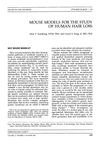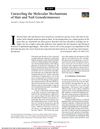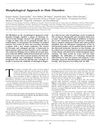TLDR A gene mutation causes a rare hereditary hair loss, offering potential for new treatments.
The study identified a mutation in the human homologue of the murine hairless gene on chromosome 8p12 in a Pakistani family with autosomal recessive atrichia universalis, a rare form of hereditary hair loss distinct from common types like androgenetic alopecia and alopecia areata. Atrichia universalis, unlike these polygenic conditions, follows a Mendelian inheritance pattern. The hairless mouse was previously suggested as a model for this condition. The discovery of a gene encoding a transcription factor crucial for hair growth could lead to new treatments targeting cytokines and growth factors involved in the hair growth cycle.
 36 citations
,
October 1996 in “Dermatologic Clinics”
36 citations
,
October 1996 in “Dermatologic Clinics” Mice are useful for researching human hair loss and testing treatments, despite some differences between species.
 23 citations
,
November 2001 in “Archives of Dermatology”
23 citations
,
November 2001 in “Archives of Dermatology” Genetic discoveries are key for understanding, diagnosing, and treating inherited hair and nail disorders.
 38 citations
,
June 2003 in “Journal of Investigative Dermatology Symposium Proceedings”
38 citations
,
June 2003 in “Journal of Investigative Dermatology Symposium Proceedings” Accurate clinical, histological, and genetic methods are key for understanding and treating hair disorders.
8 citations
,
January 2011 in “International journal of trichology” Accurate diagnosis of APL is crucial to avoid unnecessary treatments.
 3 citations
,
March 2010 in “Dermatologica Sinica”
3 citations
,
March 2010 in “Dermatologica Sinica” A Taiwanese patient had hair loss and skin bumps without the usual gene mutation, suggesting other genetic factors might be involved.
 19 citations
,
May 2006 in “Clinical and Experimental Dermatology”
19 citations
,
May 2006 in “Clinical and Experimental Dermatology” Researchers found a new mutation causing total hair loss from birth.




